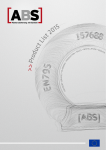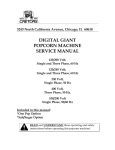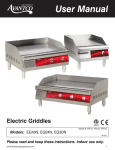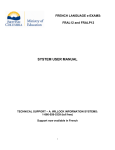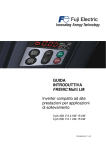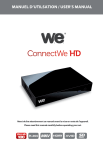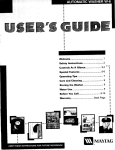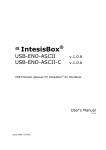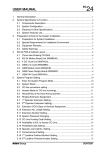Download Vulcan-Hart EG60 Service manual
Transcript
SERVICE MANUAL GAS RESTAURANT RANGE EG24, 36, 48, 60, 160 AND 260 MODEL EG24 EG36 EG48 EG60 EG160 EG260 ML-52486 ML-52487 ML-114956 ML-52488 ML-52489 ML-52490 EG36 VULCAN-HART COMPANY, FORM 31054 Rev. A (5-98) P.O. BOX 696, LOUISVILLE, KY 40201-0696, TEL. (502) 7 7 8 - 2 7 9 1 IMPORTANT FOR YOUR SAFETY THIS MANUAL HAS BEEN PREPARED FOR PERSONNEL QUALIFIED TO INSTALL GAS EQUIPMENT, WHO SHOULD PERFORM THE INITIAL FIELD START-UP AND ADJUSTMENTS OF THE EQUIPMENT COVERED BY THIS MANUAL. POST IN A PROMINENT LOCATION THE INSTRUCTIONS TO BE FOLLOWED IN THE EVENT THE SMELL OF GAS IS DETECTED. THIS INFORMATION CAN BE OBTAINED FROM THE LOCAL GAS SUPPLIER. IMPORTANT IN THE EVENT A GAS ODOR IS DETECTED, SHUT DOWN UNITS AT MAIN SHUT-OFF VALVE AND CONTACT THE LOCAL GAS COMPANY OR GAS SUPPLIER FOR SERVICE. FOR YOUR SAFETY DO NOT STORE OR USE GASOLINE OR OTHER FLAMMABLE VAPORS OR LIQUIDS IN THE VICINITY OF THIS OR ANY OTHER APPLIANCE. WARNING IMPROPER INSTALLATION, ADJUSTMENT, ALTERATION, SERVICE OR MAINTENANCE CAN CAUSE PROPERTY DAMAGE, INJURY OR DEATH. READ THE INSTALLATION, OPERATING AND MAINTENANCE INSTRUCTIONS THOROUGHLY BEFORE INSTALLING OR SERVICING THIS EQUIPMENT. IN THE EVENT OF A POWER FAILURE, THE PILOTS WILL REMAIN LIT AND THE UNIT WILL CONTINUE TO FUNCTION. UNITS EQUIPPED FOR 120 VOLT OPERATION WILL AUTOMATICALLY SHUT DOWN. SHOULD THIS HAPPEN, TURN POWER SWITCH OFF. DO NOT ATTEMPT TO OPERATE UNIT UNTIL POWER IS RESTORED. –3– GAS RESTAURANT RANGE MODELS EG60 EG36 EG160 EG260 EG48 EG24 PL-53006 –4– SERVICE MANUAL GAS RESTAURANT RANGES INDEX PLEASE KEEP THIS MANUAL FOR FUTURE REFERENCE DESCRIPTION PAGE SERVICE NOTATIONS 6 UNITS MOUNTED ON CASTERS 7 SERVICING SIMPLE CHECKS AND ADJUSTMENTS 7-10 GAS CONNECTIONS 11, 12 TESTING THE GAS SUPPLY SYSTEM 12 ORIFICE SIZE REQUIREMENTS FOR DIFFERENT ELEVATIONS 12 PILOT LIGHTING AND ADJUSTMENTS 13-17 THERMOSTAT ADJUSTMENTS 18-21 REGULATOR CHECK, ADJUSTMENT, INSTALLATION 22-24 STANDARD OVEN & GRIDDLE THERMOSTAT REPLACEMENT 24-27 OVEN PILOT CHECK, REPLACEMENT 28 STANDARD OVEN PILOT SAFETY VALVE CHECK, REPLACEMENT 29-31 THERMOCOUPLE CHECK, REPLACEMENT 32 OVEN BURNER NOZZLE AND ORIFICE CHECK, REPLACEMENT 33 OVEN BURNER CHECK, REPLACEMENT 34 TOP SECTION PILOT CHECK, REPLACEMENT 35 PILOT ADJUSTMENT VALVE REPLACEMENT 35 TOP SECTION BURNER VALVE AND NOZZLE CHECK, REPLACEMENT 36 –5– DEDICATED TECHNICAL SERVICE HOT LINE(1-502-778-2791) SERVICE NOTATIONS: 1. The procedures outlined in this manual are to be performed only by Vulcan-Hart authorized service representatives. 2. An authorized Vulcan-Hart service representative is one who is familiar with Vulcan equipment and who has been endorsed by Vulcan-Hart Company to service the equipment. All authorized service personnel are required to stock a minimum amount of parts and should be equipped with a complete set of wiring diagrams, service and parts manuals covering all Vulcan-Hart equipment. 3. For all field conversion service installation procedures, refer to the codes and compliances outlined in the installation and operation manual. 4. The unit rating plate stating model no., serial no. and unit gas type is located on the inside of the lower kick panel. 5. Caution should be taken when servicing this equipment. Some service testing is required while the unit is in operation. During these test procedures, it is advisable not to leave the unit unattended and to exercise caution during all testing operations. WARNING: THE RANGE AND ITS PARTS ARE HOT. BE VERY CAREFUL WHEN OPERATING OR SERVICING THE RANGE. –6– UNITS MOUNTED ON CASTERS Units mounted on casters utilizing a flex hose and quick-disconnect must be installed with a restraining device. The restraining device must be connected at all times. If disconnection of the device is necessary, turn off the gas supply before disconnection. Reconnect the restraint before turning the gas supply on and returning the unit to its original installation position and before beginning unit operation. SERVICING SIMPLE CHECKS AND ADJUSTMENTS The following is a list of simple checks and adjustments which are commonly associated with the malfunctioning of this equipment. Perform these checks and adjustments for relevant unit symptoms before the removal of any major parts or controls. Any service related questions for these units can be answered by calling the number on the front of this manual. CHECKS 1. Check the unit rating plate and verify that the gas type, pressure rating and voltage ratings (if applicable) are correct for the unit and the installation site affected. If not correct, make required adjustments. 2. Ensure that all unit and main gas and electrical supply lines are connected properly. (For electrical problems, check for tripped circuit breakers.) ADJUSTMENTS 1. Legs/Casters TOOLS REQUIRED: Carpenter’s level, channel locks. If the cooked product seems to be lopsided, check the leveling of the unit. Place a carpenter’s level inside the oven cavity across the oven rack(s). Level the unit from front to back and from side to side. To adjust the leveling of the unit, tilt the unit to one side and, using channel locks, unscrew the adjustable leg insert as required. Repeat this procedure as necessary for each leg. NOTE: Casters for this range are of the non-leveling type. Therefore, the surface which the unit is resting on must be level. If floor surface is not level, the unit will experience cooking problems until the range is level. Check the unit leveling again before leaving the store to ensure that the problem has been corrected. –7– SERVICING SIMPLE CHECKS AND ADJUSTMENTS (Cont.) 2. Oven Door Turnbuckle NOTE: For the 24L units, refer to procedure outlined under 2A. If the oven door is not closing properly, the door turnbuckle may require adjustment. To adjust the turnbuckle, flip down the lower front kick panel. The turnbuckle is connected between the right- and left-hand door springs (Fig. 1). With your hand, rotate the cast center piece of the turnbuckle two rotations at a time, then check the door tension. Repeat this procedure until the door works as desired. After adjustment has been made, tighten the locknuts. Fig. 1 2A. 24L Oven Door J-Bolt Assembly If the oven door is not closing properly, the door J-bolt assembly may require adjustment. To adjust the J-bolt assembly, flip down the lower front kick panel. The J-bolt assembly is connected to the right-hand bell crank arm (Fig. 2). The adjustment is made by the two 1⁄4-20 locknuts. Turn each nut in a clockwise direction to increase tension on the door; turn each nut in a counterclockwise direction to decrease the tension. Repeat this procedure until door works as desired. After adjustment has been made, tighten the locknuts. Fig. 2 –8– SERVICING SIMPLE CHECKS AND ADJUSTMENTS (Cont.) 3. Pilot Flame Height TOOLS REQUIRED: Standard flat blade screwdriver. Top Burners: To adjust pilot flame height of the unit top burners, locate the pilot adjustment screws found on the front manifold pipe. It is not necessary to remove the manifold cover, as adjustment access holes have been provided in the panel. With screwdriver, turn the adjustment screw of the pilot valve experiencing the pilot flame height problems (Fig. 3). Rotate the screw clockwise to decrease and counterclockwise to increase the flame height. Fig. 3 Oven: On rare occasions, the oven pilot may need adjustment. To do this: RO E RT S AY S O OUT R N AW C Oven Pilot Control Button Pilot Adjustment Cap H B IN 1. Remove the pilot adjustment cap (Fig. 4) PL-50117 Fig. 4 –9– SERVICING SIMPLE CHECKS AND ADJUSTMENTS (Cont.) 2. With screwdriver, adjust pilot key (located under pilot adjustment cap) to provide the proper size flame. 3. Replace pilot adjustment cap. NOTE: If unit still is not heating correctly, refer to THERMOSTAT ADJUSTMENTS on Page 18. 4. Air Shutter Adjustment TOOLS REQUIRED: Standard flat blade screwdriver. The efficiency of the oven depends on a delicate balance between the air supply and the volume of gas. Whenever this balance is disturbed, poor operating characteristics and excessive gas consumption will occur. The gas mixer balance is controlled by an air shutter on the front of the oven burner. A yellow streaming flame on the burner is an indication of insufficient air. To correct this condition, loosen the screw locking the shutter into position. Rotate the air shutter open until the burner flame begins to lift from the burner, then close the shutter slightly down again and lock it into place (Fig’s. 5 & 6). Fig. 6 Fig. 5 – 10 – GAS CONNECTIONS CAUTION: All gas supply connections and any pipe joint compound used must be resistant to the action of propane gases. Each unit is factory-equipped with the type gas specified on the rating plate. The installation gas connection is a 3 ⁄4" (19mm) 14 FPT thread ANSI schedule #40 standard pipe. Codes require that a gas shutoff valve be installed in the gas line ahead of the range. Standard units are equipped with fixed burner orifices which coincide with the proper unit operation elevation. See Orifice Size Requirements for Different Elevations on Page 12. NOTE: Do not attempt to drill out orifice sizes. Obtain proper conversion kit from Vulcan-Hart depot. Install the gas pressure regulator. NOTE: Before installing, check regulator supplied against unit rating plate gas supply. As of 7/11/90, the gas pressure regulator is NOT factory installed to this equipment. The regulator for this unit gas type is sealed within a plastic bag attached to the oven rack inside the oven cavity. This regulator must be field installed by a qualified installation/service representative. The installer must adhere to all installation and pressure testing codes outlined in the Installation and Operation manual (supplied with the equipment), and local installation ordinances. Natural gas regulators are preset for 3.7" W.C. (Water Column) (.92 kPa); propane gas regulators for 10.0" W.C.(2.5 kPa). 1. 2. 3. 4. Locate 3⁄4" (19mm) gas connection pipe extending from rear of range. Cover pipe threads with leak sealant. Screw regulator hand-tight onto pipe with regulator arrow pointing towards range body back (see Fig. 7). Using pipe wrench, tighten regulator securely in an upright position (see Fig. 7). The arrow on the regulator shows the direction of the gas flow (Fig. 7). While connecting the range to the gas supply, the pressure regulator must be mounted horizontally to ensure proper preset outlet pressure. If the regulator is reinstalled in any other position, the outlet pressure must be reset (Fig. 8). Fig. 8 Fig. 7 – 11 – GAS CONNECTIONS (Cont.) NOTE: A leak limiter is supplied with every regulator to allow excess gas pressure to escape. Do not obstruct leak limiter on gas pressure regulator as obstruction may cause regulator to malfunction. WARNING: PRIOR TO LIGHTING, CHECK ALL JOINTS IN THE GAS SUPPLY LINE FOR LEAKS. USE SOAP AND WATER SOLUTION. DO NOT USE AN OPEN FLAME. After piping has been checked for leaks, all piping receiving gas should be fully purged to remove air. TESTING THE GAS SUPPLY SYSTEM IMPORTANT: When test pressures exceed 1⁄2 psig (3.45 kPa), the range and its individual shutoff valve must be disconnected from the gas supply piping system. When test pressures are 1⁄2 psig (3.45 kPa) or less, the range must be isolated from the gas supply system by closing its individual manual shutoff valve. ORIFICE SIZE REQUIREMENTS FOR DIFFERENT ELEVATIONS FOR RESTAURANT RANGE OPEN TOP HOT TOP GRIDDLE BRO/GRID (STD) OVEN INPUT AT SEA LEVEL PER BURNER (BTU’S) 17,500 5.124 kW 20,000 5.856 kW 15,000 4.392 kW 10,000 2.928 kW 30,000 8.784 kW ORIFICE SIZE NAT/PROP NAT/PROP NAT/PROP NAT/PROP NAT/PROP Drill 47/56 mm 2.00/1.5 Drill 44/55 mm 2.20/1.35 Drill 48/57 mm 1.95/1.10 Drill 52/62 mm 1.60/1.00 Drill 36/52 mm 2.7/1.60 Drill 48/56 mm 1.95/1.15 Drill 49/57 mm 1.48/1.10 Drill 50/58 mm 1.80/1.05 Drill 45/55 mm 2.10/1.35 Drill 46/56 mm 2.05/1.15 Drill 47/57 mm 2.00/1.10 Drill 49/58 mm 1.85/1.05 Drill 50/60 mm 1.80/1.00 Drill 51/63 mm 1.70/0.9 Drill 53/65 mm 1.50/0.9 Drill 53/66 mm 1.50/0.8 Drill 54/67 mm 1.40/0.8 Drill 39/53 mm 2.50/1.50 Drill 40/54 mm 2.50/1.40 Drill 41/55 mm 2.45/1.35 SEA LEVEL TO 2000 FT 2000 FT TO 4000 FT 4000 FT TO 6000 FT 6000 FT TO 8000 FT – 12 – PILOT LIGHTING AND ADJUSTMENTS NOTE: Although pilot lighting procedures are to be performed by both installation and operation personnel, only the installation/service personnel should attempt to make any pilot, burner, or temperature adjustments to this unit. The operation personnel are authorized only to perform the procedures for pilot lighting. All adjustment procedures associated with pilot lighting must be performed by an authorized Vulcan-Hart installation or service person. While performing these procedures, do not turn the burner valves “ON” with the burner heads removed. HOT TOP AND GRIDDLE TOP BURNERS 1. Turn main gas supply “ON”. 2. Wait 30 seconds and, using a taper, light the hot top or griddle top pilot (Fig. 9). Fig. 9 3. If pilot fails to light, turn main gas supply “OFF”. Wait 5 minutes and repeat the above procedures. 4. Turn one hot top or griddle top burner valve “ON” to remove air from the gas line. Turn burner valve “OFF” when gas begins to flow. HOT TOP AND GRIDDLE TOP PILOT BURNER ADJUSTMENTS TOOLS REQUIRED: Standard flat blade screwdriver. After pilot is lit, adjust pilot burner flame, if necessary, by rotating the adjustment screw of the pilot valve located on the manifold pipe (see Fig. 3). 1. Turn burner “ON”. Burner flame should appear on burner head within a second. 2. Rotate the screw clockwise to decrease and counterclockwise to increase the flame. Nightly Shutdown: Turn burner valve “OFF”; pilot will remain lit. Complete Shutdown 1. Turn burner valve “OFF”; pilot will remain lit. 2. Turn main gas supply “OFF”. – 13 – PILOT LIGHTING AND ADJUSTMENTS (Cont.) OPEN TOP BURNERS 1. Turn main gas supply “ON”. 2. Wait 30 seconds and, using a taper, light the open top pilot (Fig. 10). Fig. 10 3. If pilot fails to light, turn main gas supply “OFF”. Wait 5 minutes and repeat the above procedures. 4. Turn one open top burner valve “ON” to remove air from the gas line. Turn burner “OFF” when gas begins to flow. OPEN TOP BURNER ADJUSTMENTS TOOLS REQUIRED: Standard flat blade screwdriver. 1. After pilot is lit, turn open top burners “ON”. 2. Adjust the burner flame, if necessary, by rotating the adjustment screw of the pilot valve located on the manifold pipe (see Fig. 3). Rotate the screw clockwise to decrease and counterclockwise to increase the flame. Nightly Shutdown: Turn burner valve “OFF”; pilot will remain lit. Complete Shutdown 1. Turn burner valve “OFF”; pilot will remain lit. 2. Turn main gas supply “OFF”. – 14 – PILOT LIGHTING AND ADJUSTMENTS (Cont.) BROILER/GRIDDLE 1. Turn main gas supply “ON”. 2. Wait 30 seconds and, using a taper, light broiler/griddle pilot (see Fig. 9). 3. If pilot fails to light, turn main gas supply “OFF”. Wait 5 minutes and repeat Steps 1 and 2. 4. Turn burner valve “ON” to purge air from the lines. Turn burner valve “OFF” when gas begins to flow. BROILER/GRIDDLE ADJUSTMENTS TOOLS REQUIRED: Standard flat blade screwdriver, lighter taper. Adjust pilot burner flame, if necessary, by rotating the pilot adjustment screw clockwise to decrease and counterclockwise to increase the burner flame. The pilot adjustment valve is located on the broiler/griddle manifold pipe. Nightly Shutdown: Turn burner valve “OFF”; pilot will remain lit. Complete Shutdown 1. Turn burner valve “OFF”; pilot will remain lit. 2. Turn main gas supply “OFF”. STANDARD OVEN NOTE: Perform open top/griddle lighting instructions before lighting oven pilot. 1. Open unit kick panel and lift up the pilot lighting hole cover (Fig. 11). Fig. 11 – 15 – PILOT LIGHTING AND ADJUSTMENTS (Cont.) 2. Light pilot by depressing the reset button located behind the kick panel (Fig. 12). Light pilot and continue to hold reset button in for 1 minute. If pilot fails to light, turn main gas supply “OFF” and wait 5 minutes before repeating Step 2. 3. After pilot is lit, turn the temperature dial to the desired setting. Nightly Shutdown: Turn oven burner valve “OFF”. Complete Shutdown 1. Turn oven burner valve “OFF”. 2. Turn main gas supply “OFF”. Fig. 12 PL-21434 PL-21433 – 16 – PILOT LIGHTING AND ADJUSTMENTS (Cont.) OVEN BURNER ADJUSTMENTS NOTE: These procedures should be performed only by a qualified Vulcan-Hart service representative. TOOLS REQUIRED: Standard flat blade screwdriver. All Restaurant Range series units equipped with pressure regulator and fixed orifices have been adjusted at the factory and should require no further adjustments. However, the efficiency of the range depends on a delicate balance between the air supply and the volume of gas. Whenever this balance is disturbed, poor operating characteristics and excessive gas consumption will occur. The gas mixer balance is controlled by an air shutter on the front of the oven burner (Fig. 15). Fig. 15 A yellow streaming flame on the burner is an indication of insufficient air. To correct this condition, open the air shutter until the burner flame begins to lift from the burner, then close the shutter slightly down and lock into place. PL-21446 – 17 – THERMOSTAT ADJUSTMENTS NOTE: These procedures should be performed only by a qualified Vulcan-Hart service representative. STANDARD OVEN Although the unit thermostats are factory positioned to their proper setting, it is not unusual for the thermostat to be knocked out of adjustment during shipment. If the oven or griddle heat response seems to be lacking after burner air shutter adjustments have been checked, perform the following adjustments. NOTE: There are two possible conditions of the thermostat that must be checked: bypass adjustment and temperature calibration. Bypass Adjustment TOOLS REQUIRED: Thermometer test instrument (not of bi-metal or mercury type), standard flat blade screwdriver. WARNING: DO NOT USE BI-METAL OR MERCURY THERMOMETERS WHEN TESTING FOOD EQUIPMENT OR PRODUCTS. CHEMICALS WITHIN THESE INSTRUMENTS MAY BE TOXIC IF EXPOSED TO FOOD. 1. Using a test instrument or thermometer, check the oven or griddle temperature (whichever is in question of heat response) against the thermostat dial setting. Place the thermocouple of the test instrument on the center of the oven rack. Light the main burner by turning the thermostat to 500°F (260°C). Allow at least 10 minutes for temperatures to stabilize. Check reading against dial setting. 2. If temperature is out of calibration, allow unit to cool until the oven bottom or griddle plate (whichever is being tested) is cool to the touch. Remove oven bottom or griddle plate to expose burner area (Fig. 16). (Removal of oven bottom is an optional procedure. Burner flame may also be observed through the oven view port.) Fig. 16 – 18 – THERMOSTAT ADJUSTMENTS (Cont.) 3. Light the burner. Turn the dial to the highest set temperature. 4. After 10 minutes, turn the dial clockwise to the point slightly beyond the first mark on the dial (shown by an “X”). 5. Remove the dial and sleeve (Fig. 17). Fig. 17 Fig. 18 6. With a screwdriver, turn the left-hand bypass adjustor screw counterclockwise to increase the flame, clockwise to decrease it, until the flame appears to be 1⁄8" (3.175mm) over the entire burner area (Fig. 18). 7. Reinstall the sleeve and dial. Turn the dial clockwise until it locks into the “OFF” position. 8. Reinstall oven bottom or griddle plate. Temperature Calibration TOOLS REQUIRED: Thermometer test instrument (not of bi-metal or mercury type), standard flat blade screwdriver. WARNING: DO NOT USE BI-METAL OR MERCURY THERMOMETERS WHEN TESTING FOOD EQUIPMENT OR PRODUCTS. CHEMICALS WITHIN THESE INSTRUMENTS MAY BE TOXIC IF EXPOSED TO FOOD. 1. Using a test instrument or thermometer, check the oven or griddle temperature (whichever is in question concerning heat response) against the thermostat dial setting. For Ovens: Place the thermocouple of the test instrument in the center of the oven rack. For Griddles: Place the thermocouple in the center of each individual griddle section. Each griddle section must be tested. 2. Light the main burner by turning the thermostat to 500°F (260°C). – 19 – THERMOSTAT ADJUSTMENTS (Cont.) 3. Allow unit to heat until the burner flame is heard cutting “OFF”. Wait about 10 minutes until the burner flame has cycled “ON” and “OFF” several times. Then compare the test instrument reading with the dial setting. If the reading is within ± 15°F (-9.4°C) of the dial setting, its calibration is correct. If reading is not within this temperature window, then recalibrate by performing Steps 4 through 13. 4. Pull the dial straight off the dial shaft (see Fig. 17). 5. Using a screwdriver placed through the dial shaft, push the metal dial insert out of the dial (Fig. 19). Fig. 19 6. Replace the dial back onto the unit. Turn the dial to the 400°F (204.4°C) mark and light the oven burner. 7. After the oven has been on for at least 15 minutes, check the oven temperature. NOTE: Keep door open only as long as necessary to obtain the reading. 8. Continue to monitor the oven temperature readings every 5 minutes until two successive readings within 5°F (-15°C) of one another are obtained. 9. Check the successive reading against the thermostat dial. If the reading is within ± 15°F (-9.4°C) of the dial setting, the thermostat calibration is correct. If the reading is incorrect, the thermostat must be recalibrated. – 20 – THERMOSTAT ADJUSTMENTS (Cont.) 10. To recalibrate, hold the thermostat dial in place. Insert screwdriver into dial shaft to engage the calibration stem adjustment screw (Fig. 20). Push inward (do not turn stem). Fig. 20 11. While holding stem calibration screw in place, turn thermostat dial until it is set on the actual temperature shown by the testing device (Fig. 21). Fig. 21 12. Release the calibration screw and reinstall the dial insert. 13. Set the dial to 450°F (232.2°C) and recheck temperature reading as described in Steps 7 through 9. If calibration is not within ± 15°F (-9.4°C) of the dial setting, the thermostat must be replaced. – 21 – REGULATOR CHECK, ADJUSTMENT, INSTALLATION REGULATOR CHECK A regulator is installed on each range. When servicing this equipment for possible gas pressure problems, the following visual checks should be made first. Make sure the regulator has been installed at the rear of the unit with arrow pointing in the horizontal position in the direction of gas flow. The only exception to this rule is if the outlet pressure of the unit has been reset prior to this service call. Then turn on the range top burners. Observe the burner flames. If you notice the flames fluctuating, perform the following procedures. NOTE: Gas supply pressure must not be greater than 1⁄2 psig (14" Water Column) (3.448 kPa). All ranges should be installed utilizing an individual gas line shutoff valve. The range and its individual shutoff valve must be disconnected from the gas supply piping system during any pressure testing of that system at test pressures in excess of 1⁄2 psig (3.45 kPa). In addition, the appliance must be isolated from the gas supply piping system by closing its individual manual shutoff valves during any pressure testing of the gas supply piping system at test pressures equal to or less than 1 ⁄2 psig (3.45 kPa), as stated by the American National Standards Z83.11 (latest edition). Copies of this standard are available from The American Gas Association, 1515 Wilson Blvd., Arlington, Virginia 22209. A leak limiter is supplied with every regulator to limit gas leakage if regulator rupture occurs. Do not obstruct leak limiter on gas pressure regulator as obstruction may cause regulator to malfunction. TOOLS REQUIRED: Manometer, flat blade screwdriver, 6" adjustable wrench, slip joint plier or pipe wrench. 1. Connect the manometer to the pressure tap provided on the manifold pipe near the regulator (Fig. 23). Fig. 23 – 22 – REGULATOR CHECK, ADJUSTMENT, INSTALLATION (Cont.) 2. With only two open top burners “ON”, note the manometer reading. The reading should be 3.7" Water Column (.92 kPa) for natural gas units and 10.0" Water Column (2.5 kPa) for propane gas units. If readings taken are lower, check the incoming line pressure. NOTE: The line pressure should never drop below 5.0" Water Column (1.25 kPa) for natural gas or 11.0" Water Column (2.7 kPa) for propane gas. If line pressure is incorrect, it must be adjusted in order to properly operate the unit . If the line pressure is good, then the regulator requires adjustment (refer to procedures for regulator adjustment). If, after the regulator adjustment has been made, the 3.7" Water Column (.92 kPa) (natural gas) or 10.0" Water Column (2.5 kPa) (propane gas) still is not being maintained, replace the regulator. 3. With the regulator now reading 3.7" Water Column (.92 kPa) (natural gas) or 10.0" Water Column (2.5 kPa) (propane gas), turn two open top burners “ON”. 4. Recheck the pressure reading. The reading should not fluctuate more than ± .10" (0.7 kPa). If reading is not within tolerance, replace the regulator. NOTE: When the burners are “OFF”, if the pressure reading climbs to an outlet regulator pressure stated in Step 2, check the regulator vent for obstruction (Figs. 24 & 25). Fig. 24 Fig. 25 Check also for gas leak at vent. If vent is leaking gas, replace the regulator. REGULATOR ADJUSTMENT TOOLS REQUIRED: Flat blade screwdriver, manometer, and 6" adjustable wrench. NOTE: Before making a regulator adjustment, always verify that the incoming line pressure is correct. The required incoming minimum line pressure for the Restaurant Range series is 5.0" (1.25 kPa) for natural gas and 11.0" (2.7 kPa) for propane gas. If the line pressure is not correct, it must be rectified or the unit will not properly operate or achieve proper regulator adjustment. Also, the regulator must be attached to the unit in the horizontal position with the arrow pointing in the direction of the gas flow (see Fig. 7). – 23 – REGULATOR CHECK, ADJUSTMENT, INSTALLATION (Cont.) 1. Connect the manometer to the pressure tap provided on the rear manifold pipe (see Fig. 23). 2. Check the reading. The reading should be 3.7" Water Column (.92 kPa) for natural gas and 10.0" Water Column (2.5 kPa) for propane gas. 3. If reading is incorrect and the proper line pressure has been verified, then the regulator must be adjusted. Using a standard flat blade screwdriver, remove the regulator adjustment cap (Figs. 26 & 27). Fig. 27 Fig. 26 Insert the screwdriver into the adjustment shaft and turn the adjustment stop while watching the manometer until the correct pressure reading is achieved. Clockwise rotation of the stop increases pressure; counterclockwise rotation decreases pressure. After resetting the pressure to the correct setting, reinstall the adjustment cap and remove the testing equipment. REGULATOR INSTALLATION TOOLS REQUIRED: Slip joint plier or pipe wrench. NOTE: The pressure regulator must be attached to the unit in the horizontal position with the arrow pointing in the direction of the gas flow, unless at some point in time the regulator has been recalibrated (see Fig. 7). 1. Turn main gas supply “OFF”. 2. Remove old regulator. 3. Wrap the manifold pipe threads of the insulating end with pipe thread sealant. 4. Install new regulator as indicated by the above NOTE. 5. Turn main gas supply “ON” and check the regulator connections for gas leakage using a soap and water solution. If no leaks are found, return unit to full operation. If leak is detected, turn main gas valve “OFF” and eliminate leakage. – 24 – STANDARD OVEN & GRIDDLE THERMOSTAT REPLACEMENT STANDARD OVEN AND GRIDDLE THERMOSTAT CHECKS AND CALIBRATION Refer to THERMOSTAT ADJUSTMENTS on Page 18 of this manual for the procedures for checking and calibrating the thermostat for the standard oven and griddle. STANDARD OVEN AND GRIDDLE THERMOSTAT REPLACEMENT TOOLS REQUIRED: Pipe wrench, 6" adjustable wrench, 1⁄8" flat blade screwdriver, 5⁄16" socket, and socket wrench. 1. Disconnect unit gas supply and allow unit to cool. 2. From inside the oven cavity, remove the capillary bulb from the clips mounted to the cavity back wall (Fig. 28). Fig. 29 Fig. 28 3. Remove the top grates or griddle sections required to access the thermostat and capillary wiring (Fig. 29). – 25 – STANDARD OVEN & GRIDDLE THERMOSTAT REPLACEMENT (Cont.) 4. From inside the oven, straighten the capillary lead. From the opening in the oven top section, pull the capillary out of the oven cavity (Fig. 29). Fig. 30 5. Remove the top section burner valve knobs, top grates and aeration plate. (Figs. 30) 6. Remove screws holding the control panel in place. 7. Disconnect the thermostat burner tubing (Fig. 31). Fig. 31 8. Remove top burners, if required, to access the thermostat. – 26 – STANDARD OVEN & GRIDDLE THERMOSTAT REPLACEMENT (Cont.) 9. Unscrew the thermostat from the manifold pipe (Figs. 33, 34, & 35). Fig. 34 Fig. 33 Fig. 35 10. Replace thermostat mounting block. Place pipe dope on the threaded end of the new thermostat mounting block to be installed onto the unit. 11. Install the new thermostat by reversing Steps 1 through 9 above. NOTE: Do not kink the new capillary line when feeding it through the oven cavity. The capillary wire may be wrapped loosely around the gas tube to keep the wire from laying detached in the top section burner area. Also, using a soap and water solution, the thermostat must be tested for gas leak after being installed. – 27 – OVEN PILOT CHECK, REPLACEMENT OVEN PILOT CHECK If all other systems have been checked and pilot will not stay lit, replacement of the pilot may be necessary. OVEN PILOT REPLACEMENT TOOLS REQUIRED: 1⁄4" socket, socket driver, 1⁄2" and 7⁄16" open end wrenches. 1. Disconnect unit from main gas supply and allow unit to cool. 2. Remove oven bottom assembly (see Fig. 16). 3. Disconnect pilot from gas tubing (Fig. 41). Fig. 41 4. Remove (2) #8 sheet metal screws holding pilot bracket in place. 5. Lift bracket away from oven burner. 6. Remove pilot from bracket. 7. Remove pilot by following Steps 1 through 5 in reverse order. – 28 – STANDARD OVEN PILOT SAFETY VALVE CHECK, REPLACEMENT STANDARD OVEN PILOT SAFETY VALVE CHECK NOTE: A quick check of the following conditions and symptoms will assist in verifying that the pilot safety valve is properly functioning. TOOLS REQUIRED: Flow meter, millivolt tester. If the unit pilot is “ON” but the unit is not heating, check the gas flow from the thermostat to the safety valve, using a flow meter (Fig. 36). (Flow meter kits are available from Vulcan-Hart Service Parts Depots under Part No. 495.) FOR PROPER USAGE OF FLOW METER, REFER TO THE MANUFACTURER’S INSTRUCTIONS PROVIDED IN THE FLOW METER KIT. Fig. 36 The meter should show signs of massive flow. If flow is not found, replace the thermostat and recheck gas flow. If meter does show signs of gas flow, then perform the following checks on the safety valve. If there is an obvious problem with the pilot safety valve, the unit will not heat and pilot outage will occur. 1. Fold down lower kick panel. 2. Perform the pilot lighting procedures (see Page 13). 3. If pilot will not stay lit, check pilot for clogging. 4. If the unit still will not stay lit, using a volt meter, check the millivolt reading from the valve thermocouple connection while holding the pilot button in the “ON” position (Fig. 37). – 29 – STANDARD OVEN PILOT SAFETY VALVE CHECK, REPLACEMENT (Cont.) Fig. 37 5. If the millivolt reading is below 5 MV, replace the thermocouple. 6. If the MV reading is within tolerance, the safety valve should be replaced. SAFETY VALVE REPLACEMENT PROCEDURES TOOLS REQUIRED: 7⁄16" open end wrench, 11⁄16" open wrench, and 3⁄8" open end wrench. 1. Disconnect unit from main gas supply. 2. Disconnect thermocouple from safety valve (Fig. 38). Fig. 38 – 30 – STANDARD OVEN PILOT SAFETY VALVE CHECK, REPLACEMENT (Cont.) 3. Disconnect right- and left-hand pilot gas tubing from the safety valve (Fig. 39). Fig. 39 4. Disconnect right- and left-hand burner gas tubing from the safety valve (Fig. 40). Fig. 40 5. Remove safety valve from unit. 6. Install new valve by reversing Steps 1 through 4. – 31 – THERMOCOUPLE CHECK, REPLACEMENT THERMOCOUPLE CHECK 1. Fold lower kick panel down. 2. Perform pilot lighting procedures (see Page 13). 3. If unit will not stay lit, using a volt meter, check the millivolt reading from the valve thermocouple connection while holding pilot button in the “ON” position (see Fig. 37). 4. If millivolt reading is below 5 MV, replace thermocouple. THERMOCOUPLE REPLACEMENT TOOLS REQUIRED: 7⁄16" open end wrench, 3⁄8" open end wrench, 1⁄4" socket and socket driver. 1. Disconnect unit from main gas supply. 2. Remove 7⁄16" nut holding thermocouple to pilot bracket. 3. Remove thermocouple from bracket (Fig. 42). Fig. 43 Fig. 42 4. Feed thermocouple assembly through front burner box (Fig. 43). 5. Remove thermocouple lead from safety valve (see Fig. 38). 6. Install new thermocouple by reversing Steps 1 through 5. NOTE: Be careful not to kink new thermocouple wire during the installation process. – 32 – OVEN BURNER NOZZLE AND ORIFICE CHECK, REPLACEMENT OVEN BURNER NOZZLE AND ORIFICE CHECK If burner operation seems poor and all other systems have been verified, remove burner nozzle and orifice to check for blockage or damage. Blockages can often be cleaned using water pressure and a mild soap solution or by running a correct size drill tap through the nozzle opening. OVEN BURNER NOZZLE AND ORIFICE REPLACEMENT TOOLS REQUIRED: 1⁄2" open end wrench. 1. Disconnect unit from gas and allow unit to cool. 2. Follow steps listed under the replacement of the safety valve in order to access the oven burner nozzle. 3. Remove burner nozzle. 4. Remove orifice spud. 5. Check for blockage or damages (Fig. 44). NOTE: If blockage is apparent, the obstruction can either be cleaned or the entire nozzle assembly replaced. Verify also that the proper nozzle orifice size is being used, and verify BTU rating with flow meter. (Flow meter kits are available from Vulcan-Hart Service Parts Depots under Part No. 420000.) FOR PROPER USAGE OF FLOW METER, REFER TO THE MANUFACTURER’S INSTRUCTIONS PROVIDED IN THE FLOW METER KIT. Fig. 44 – 33 – OVEN BURNER CHECK, REPLACEMENT OVEN BURNER CHECK If the oven burner is not properly firing and all other systems have been checked, the oven burner may need to be cleaned or replaced. OVEN BURNER REPLACEMENT TOOLS REQUIRED: 1⁄4" socket and socket driver. 1. Disconnect unit from main gas supply and allow unit to cool. 2. Remove burner strap-down tie if applicable. 3. Remove (2) #8 sheet metal screws securing burner to pilot bracket (Fig. 45). Fig. 45 4. Tilt burner upward and slide burner away from burner nozzle (see Fig. 43). 5. Reinstall new burner by reversing Steps 1 through 4. – 34 – TOP SECTION PILOT CHECK, REPLACEMENT TOP SECTION PILOT CHECK If all other systems have been checked and pilot will not stay lit, cleaning or replacement of pilot may be necessary. TOP SECTION PILOT REPLACEMENT TOOLS REQUIRED: 7⁄16" open end wrench. 1. Disconnect unit from main gas supply and allow unit to cool. 2. Remove defective pilot from pilot tube. 3. Check pilot for blockage. 4. If blockage is found, clean pilot tip and replace or install new pilot tip. 5. If blockage is not found but pilot appears to be malfunctioning, check pilot tube and pilot adjustment valve for obstructions. PILOT ADJUSTMENT VALVE REPLACEMENT TOOLS REQUIRED: 7⁄16" open end wrench, pipe wrench or a 6" adjustable wrench. 1. Disconnect unit from main gas supply. 2. Disconnect pilot tubing (Fig. 46). Fig. 46 3. Remove valve from unit manifold. 4. With pipe dope covering the threads, install new pilot valve by reversing procedures 1 through 3. – 35 – TOP SECTION BURNER VALVE AND NOZZLE CHECK, REPLACEMENT TOP SECTION BURNER VALVE CHECK After a long period of use on the range, the top section burner valve can show signs of wear. Check valve for gas leakage and sloppy valve control. Check also for valve nozzle blockage or damage. TOP SECTION BURNER VALVE AND NOZZLE REPLACEMENT TOOLS REQUIRED: 1⁄2" open end wrench, 6" adjustable wrench or standard pipe wrench, 1⁄4" socket and socket driver. 1. Disconnect main unit gas supply. 2. Remove control panel cover and top grates or griddle section. 3. Remove and check valve and valve nozzle for obstructions and damage. 4. Remove obstruction, or if necessary, replace nozzle or entire valve. When reinstalling, or if the installation of a new valve is required, be sure to use pipe thread sealant on the threaded end which engages the manifold pipe. FORM 31054 Rev. A (5-98) – 36 – PRINTED IN U.S.A.




































